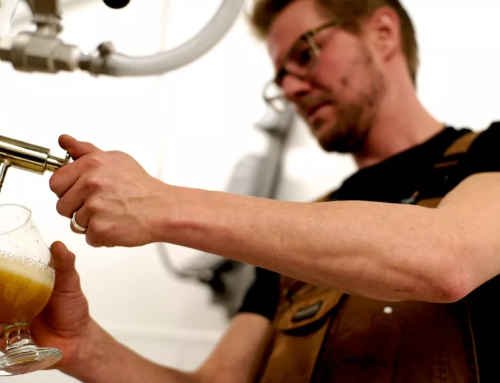American producers produce the best mead the world has ever known?
But what is France, the cradle of wine and all spirits, doing? Are we waiting for the Americans to do it first?

While the origins of mead date back at least 20,000 years to prehistoric Ethiopia, where wild bees nested high in the tops of ancient trees, and to the dawn of the Neolithic era in northern China nearly 10,000 years ago, the drink remains relatively mysterious to the average American consumer.
Many consumers vaguely associate this drink with medieval Europe, if at all.
But this could change.
According to the American Mead Makers Association (AMMA), the number of commercial meaderies in the United States has increased by 650 % since 2003.
And the group promoting the development of this drink claims that more than 200 meaderies are planning to open over the next two years.

According to Investment Weekly News, the global mead market was valued at over $408 million in 2018 and is expected to exceed $800 million by 2025.
Why did it take so long for mead to become a popular market?
First impressions from consumers can make or break a fledgling business in any industry, and when it comes to fermented honey, it's particularly difficult to overcome the tendency to assume that all meads are created equally.
"It's too sweet" or "it tastes like medicine" are crude reactions that irritate producers like nails on a chalkboard, because they sum up the obstacles that have limited the commercial evolution of mead for millennia.
Fortunately, a colony of innovators across the United States is changing these perceptions.
Thanks to traditional techniques and ingredients, as well as cross-category and cross-cultural collaboration, the renaissance of mead is underway.
Arizona's central valleys produce some of the country's largest wildflower blooms each year, making the southwest a natural destination for mead makers.

"Where honey comes from is where mead comes from, and there's nothing like Arizona's desert wildflower honey," says Carvin Wilson, AMMA's 2019 National Mead Maker.
The area is home to the Meadery Superstition, run by Jeff and Jennifer Herbert.
The Herberts have nurtured their passion for home brewing into one of the world's largest meaderies, as well as a restaurant serving meals with mead in downtown Phoenix.
"When we founded Superstition in 2012, there were only around 150 national producers, and there was no national industry organisation to represent our interests," explains Jeff.
"So, right after we launched our startup, we became founding members of AMMA, and in the interim, the commercial landscape has undergone an amazing transformation to over 600 meaderies in the US."
Superstition now monitors fermentation markers, works with craft brewers and has a diversified product range.
Two of the nation's oldest meaderies are B. Nektar and Schramm's, in Michigan, both built on the land of abundant Midwestern apiaries.
"I think what has changed things is the growth and evolution of the craft beer industry," says Brad Dahlhofer of B. Nektar, which has produced nearly 200 recipes and is currently the largest meadery in the US.
B. Nektar, which has produced nearly 200 recipes, is currently the largest meadery in the United States.
B. Nektar's strategy of marketing experimental styles in limited quantities to curious craft beer drinkers has become the model for introducing consumers to the flavour profiles of mead.
For example, B. Nektar's Miel de Garde is ranked as the fifth best mead in the world by RateBeer.com in the "Other" category. It is made from orange blossom honey using a traditional process, but is aged for 18 months in oak barrels like a wine.
Schramm's recently teamed up with Beer Kulture, a Florida-based non-profit organisation that has previously released beers in partnership with Green Bench Brewing, to create a collaborative mead.
AMMA, in collaboration with the Beer Judge Certification Program (BJCP), has established stylistic guidelines to fuel healthy competition in emerging mead hybrids.
"Modern winemaking techniques have made the meads produced over the last decade probably the best the world has ever seen, and the range of craft meads available is wider than at any time in history," says Jeff Herbert.
Chrissie Manion Zaerpoor, author of The Art of Mead Tasting & Food Pairing, says that consumer unfamiliarity and a limited number of recipes stunted the growth of the mead industry until Charlie Papazian published The Complete Joy of Home Brewing in 1984. This book launched the careers of hundreds of brewers who revolutionised the drinks industry, including mead.
"I started my craft journey as a home brewer and, like most home brewers trying their hand at making mead, was intrigued after reading about it in the back of Charlie Papazian's cookbooks, which most of us cut our teeth on," says Billy Beltz, owner of Lost Cause Meadery in San Diego. "The first batch I made was, of course, awful, but I immediately fell in love with the challenge and possibilities of mead." Other mead makers see huge potential for the category.
"There is a growing trend in the American craft beverage industry to move beyond the traditional labels of beer, wine, cider, etc. and break down some of the artificial segmentation and dogma," says Billy Beltz, co-founder of San Diego's Lost Cause, which has been the most decorated meadery for two consecutive years at the Mazer Cup, the world's largest mead competition.
"Mead is the wrecking ball that will end up opening up a lot of this," says Beltz.
Many manufacturers are also pursuing cross-cultural collaborations. Rabbit's Foot has developed a network in Ireland to produce Celtic 100% meads. Superstition has teamed up with a Brazilian start-up to create the largest meadery in South America. And researcher Garth Cambray, from Makana Meadery in South Africa, recently published a thesis on a revolutionary process for transforming unfermented honey into mead with 12 % alcohol by volume (abv) in 24 hours.
As mead reaches a tipping point in public consciousness, consumers will determine how craft is defined by the producers they support. Should mead stick to familiar flavours to be widely available? Or should it focus on developing unique combinations to celebrate local characteristics?
The answer to both these strategies, like the fermentation process itself, comes down to quality control. After fermenting for millennia, the golden age of mead may have finally arrived. And the results have certainly been worth the wait.
So, let's go around the world, friends of the French-speaking world: extraordinary honeys, incomparable fruits and for some unique spices!
Finally, a shared love of gastronomy and taste. So let's get on with it, take up the challenge or leave the Americans in front once again 🙂
Back to your laboratories and alchemist's workshops to prepare long in the mouth. And spread the word!










Great article.... now it's time to get started!
Hello Eloise, that's why we're here! https://pretasurvivre.com/courses. Thank you and have a nice day.
Hello, thank you for this very interesting article
very interesting! And the revolution is also coming to France!
-> https://bullesderuche.fr/
Well done Paul-Augustin for your mead production and your lovely online site. We've been following you for some time now. We hope to be able to taste one of your creations very soon!